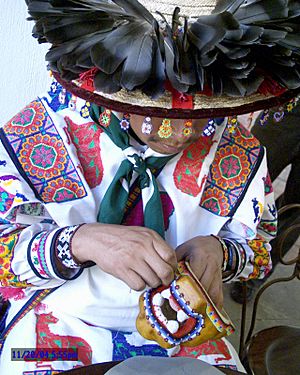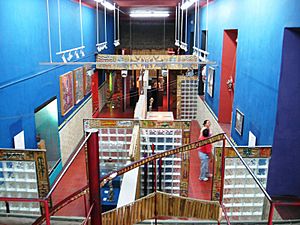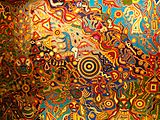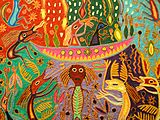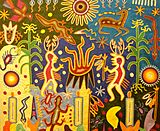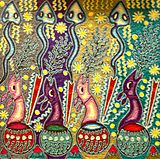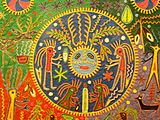Huichol art facts for kids
Huichol art is a special kind of folk art made by the Huichol people in Mexico. They live in states like Jalisco, Durango, Zacatecas, and Nayarit. What makes their art unique is its bright colors and designs that have been used for hundreds of years.
The most popular Huichol artworks are "yarn paintings" and objects covered in tiny, colorful beads. Yarn paintings are made by pressing yarn onto boards covered with wax and resin. These paintings come from a ceremonial tablet called a nierika. The Huichol people have a long history of making beads from things like clay, shells, and seeds. They used these to create jewelry and decorate bowls. Today, their beadwork often covers masks and wooden sculptures with small, bright, store-bought beads.
Even though the materials have changed, the designs in Huichol art are still very old. Many of them keep their original religious and symbolic meanings. Tourists often see Huichol art in places like Guadalajara and Puerto Vallarta. However, they might not know much about the artists or the deep meanings behind the designs. Some Huichol artists are very famous for their yarn paintings and beadwork. Their art is even displayed in public places and is considered very valuable.
Contents
The Huichol People
The Huichol people are an indigenous group living mostly in the mountains of northern Jalisco and Nayarit, Mexico. Important cultural centers for them include San Andrés, Santa Catarina, and San Sebastián. There are about 50,000 Huichol people. Their name, Huichol, comes from the word Wirriarika, which means "soothsayer" or "medicine man" in their language.
When the Spanish arrived in the 1500s, the Huichols moved deeper into the rugged mountains. This isolation helped them keep their ancient culture and beliefs mostly untouched. The Spanish didn't find many valuable resources in their area, so they left the Huichols largely alone. Many experts believe the Huichols have kept their old belief systems better than almost any other group in Mexico. Even today, they prefer to stay isolated. However, some Huichols now travel to cities like Guadalajara to work or sell their art.
The Huichol religion still focuses on three important things: the deer, corn, and peyote. Peyote is a plant that is gathered each year during a long trip to the desert of San Luis Potosí. Shamans (spiritual leaders) use peyote in their rituals. The importance of these three elements and their gods is shown in almost everything the Huichol people decorate. They did not have a written language until recently. So, these symbols were, and still are, the main way they pass down their ceremonies, myths, and ancient religious beliefs.
Yarn Painting and Beadwork
The most famous Huichol art today uses modern materials like yarn and small beads. The Tepehuánes people of Durango also adopted yarn painting. These new materials have replaced older ones like clay, stone, and natural dyes. However, making and decorating with beads is not new to the Huichol. They made beads from bone, clay, stone, coral, and seeds long before European glass beads arrived. Huichol art was first studied in the late 1800s by Carl Lumholtz. He documented their beaded earrings, necklaces, and anklets.
What connects today's yarn paintings and beaded objects is the use of traditional patterns. These patterns have been used for centuries to talk with the gods. Modern materials allow for more detailed designs and brighter colors. This also means they can create art for sale, alongside items used only for religious purposes.
The selling of Huichol art began when a Franciscan priest named Ernesto Loera Ochoa opened a Huichol museum. This museum was near Guadalajara. Ramón Medina Silver was one of the artists whose work was shown and sold there. An American named Peter Furst saw Medina's work. He suggested that Ramón show his people's traditions by pressing colored yarn onto a wax and resin board. These yarn paintings first appeared in 1962. They came from "nierikas," which were small boards or discs with a hole or mirror. Shamans first made nierikas to show visions they had while using peyote. They would leave them as gifts for the gods in sacred places.
These modern yarn paintings quickly became popular, and other artists started making them too. They have grown into complex designs that can take weeks to finish. Yarn paintings also led to trying other materials like beads. Many Huichol artists now use beads instead of yarn. This beadwork has expanded to decorate jaguar heads, masks of the sun and moon, and different animal shapes.
This art, made for selling, has given the Huichol people an important way to earn money. Even with new materials, they keep their traditional symbols alive and teach them to younger generations. However, selling art for money has caused some debate. Some people question how "authentic" the yarn and bead art is, since its current form is modern. But most people agree that as long as traditional symbols are used, the art is still authentic. Some Huichol items, like Christmas decorations or masks of the sun and moon, are less traditional. Also, adding modern images like airplanes into designs is new. Selling their art has been hard for the Huichol. They mostly sell to tourists or to middlemen who earn much more from the art than they do.
Noted Huichol Artists
Some famous Huichol artists include Emeteria Ríos Martínez, who has created many yarn painting murals. José Benítez Sánchez is a shaman-artist. He helped yarn painting grow from simple decorations to larger, more vision-like pieces. Pablo Taizan is also a shaman who mainly creates beadwork of animal figures used for healing. Santos de la Torre made a large mural for a metro station in Paris, France. In 2013, a Mexican documentary called 'Echo of the Mountain' was made about his experiences creating this mural.
More Traditional Items
While yarn paintings and beaded items are the most well-known, the Huichols still make many other traditional crafts. Urus, or prayer arrows, are ceremonial arrows. They are shot into the air to ask gods for blessings. Sometimes they are left in special places or sent down rivers. These arrows are decorated with symbols related to the prayer.
For a very long time, men, women, and children have worn woven bags around their waists. They use these bags to carry personal items. The bags are colorful and decorated to look nice and to magically protect the person wearing them.
A "kuka" is a three-dimensional ceremonial mask decorated with beads. These masks developed from small gourd bowls that were originally covered with seeds, bone, clay, and shells. Now, store-bought beads are used instead. From these masks came the modern practice of covering wooden sculptures of snakes, dolls, small animals, and jaguar heads with beads.
Nearika are highly decorated ceremonial objects. They can be circular or diamond-shaped. Carl Lumholtz, who studied the Huichol, called the circular ones "frontal shields" and the diamond-shaped ones "eyes." This led to the idea of "God's eyes," which is a type of Huichol cross. Nearika are wooden or bamboo tablets that are heavily decorated. They are placed in sacred areas. Often, they show a face of the sun, moon, or a person. The new tradition of yarn paintings grew from these, and the most traditional yarn paintings still show the round face of Tau, the Sun, in the middle.
Huichol Decorative Designs
Most Huichol patterns and designs have important religious and cultural meanings. You can find these patterns on many different objects. These include carved and beaded masks, gourds, musical instruments, and embroidered clothing like belts and bags. Many designs are influenced by visions that happen during peyote rituals. Carl Lumholtz gathered much of what we know about Huichol designs in the late 1800s. Since then, Huichol art has become even more varied. However, plant and animal designs are still the most common and usually keep their original meaning.
When ceremonial or religious items are made, every detail is important. This includes the materials, colors, and designs. They are all linked to specific gods and meanings. For example, mesquite wood and the color reddish-brown belong to Tatewari, the god of the earth. Wood from the Brazil tree is linked to Tayaupa, or "Father Sun." Symbols like the golden eagle and macaws are also connected to Tatewari. Shapes like the deer, coyote, pine tree, or whirlwind can be linked to Tamat's Kauyumari, who shaped the world. The salate tree, the armadillo, and the bear are connected to Takutzi Nakahue, the mother of all gods and of corn. The toto is a small white flower with five petals. It is linked to the rainy season. Belts often have designs that look like the markings on snakes' backs. Snakes are also linked to rain, good crops, health, and long life. The zigzag lines that come from all living things show communication with the gods. The butterfly design reminds people of the Itzpapolotl, or Obsidian Butterfly, an important god of the ancient Aztecs.
The most common designs are related to the three most important things in Huichol religion: the deer, corn, and peyote. The deer and corn are important because they are main sources of food. Peyote is used by shamans in their rituals.
Exhibitions of Huichol Art
Most people outside the Huichol community see Huichol art when they visit places like Guadalajara and Puerto Vallarta. The people selling the art are usually Huichol women who come from rural villages.
Huichol artwork can be very small or as large as murals. In 2010, the Institute of the Americas at the University of California, San Diego, had an exhibit of Huichol art. It was for tourists visiting the west coast of Mexico.
The Museo de Arte Popular in Mexico City had a special exhibit in 2009. It compared Huichol art with art from the aborigines of northern Australia. The exhibit was called "Huichol Magic: Aborigine Ritual." It aimed to show how similar the styles were between these two very different cultures.
The art gallery "Arte Marakame" in Morelia, Michoacan, Mexico, has a permanent display of Huichol art. This includes pieces made with crystal beads and yarn paintings. They also show a mix of Huichol art and Alebrije from Oaxaca.
The Bead Museum in Glendale, Arizona, also had an exhibit called "The Huichol Web of Life: Creation and Prayer."
Huichol art has been specially made for public places. There are twelve Huichol murals permanently displayed at the San Diego International Airport at Terminal 3. A Huichol bead mural was also made for the Paris Métro at the Palais Royal-Musee de Louvre station. The Mexico City Metro gave this mural to France. It was a thank you for the Art Nouveau Bellas Artes station entrance that France had given to Mexico. This artwork is called "Huichol Thought and Soul." It is 2.4 by 3 meters in total, made of 80 smaller panels. Artist Santos de la Torre created it.
One of the newest commissioned works is the "Vochol." This is a Volkswagen Beetle car covered in Huichol designs. It has 2,277,000 beads attached to the car with a special heat-resistant resin. The car was made to be sold at an auction. The money raised would help Mexican artists.
See also
 In Spanish: Arte huichol para niños
In Spanish: Arte huichol para niños


